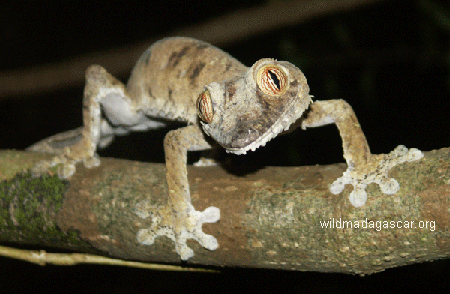|
|
|
Madagascar to Triple Protected Areas by 2008
Madagascar Readies More Protected Nature Sites
Story by Tim Cocks
Reuters
MADAGASCAR: November 8, 2004
ANTANANARIVO - Madagascar has identified the additional forests, wetlands and marshes it wants to protect under a plan to triple the size of its nature reserves by the end of 2008, a global conservation group said.
|

|
|

|
|
(top) Leaf-tailed gecko (Uroplatus fimbriatus) in Masoala National Park, Madagascar. (bottom) Isalo National Park.
|
Wildlife on the world's fourth largest island is under growing threat from poverty and population pressure, an issue of global environmental concern because three-quarters of its estimated 200,000 plant and animal species exist nowhere else.
Seventy-five percent of the giant island's 17 million people live on less than a dollar a day, most of them eking out a living as subsistence farmers, where competition for land is encroaching on the island's remaining forest.
President Marc Ravalomanana pledged to boost its protected spaces to six million hectares from the present 1.7 million in September last year at a World Parks Congress in South Africa.
"We've now identified all of the six million hectares (14.83 million acres) of priority areas," said World Wildlife Fund (WWF) representative Jean Paul Paddack, told Reuters.
He said the plan was to increase Madagascar's total national parks to 2.4 million hectares from the present 1.7 million.
"The remainder (of the six million) would then be (made up of) additional marine areas, wetlands, marshes and forests, which will be provided a formal conservation status," he said, adding that agreements had been reached with local communities in the areas to be conserved.
WWF, which is working with the government on the plan, calls itself the world's largest privately financed international body seeking to protect threatened wildlife and their habitats.
"Since the president made his pledge, the entire environmental community has worked with the government and local people in the areas developing a road map," Paddack said.
The Indian Ocean island broke from Africa 165 million years ago, leaving it to evolve an ecosystem that has 10,000 plant species, 316 reptiles and 109 bird species found nowhere else.
Traditional "slash-and-burn" agriculture in which forests are cleared for planting subsistence crops such as rice has decimated the island's rainforest cover, conservationists say.
Paddack said teaching new farming technique was one way in which WWF and the government were trying to curb slash-and-burn.
"We are telling them there are more efficient ways of producing rice, like the new intensive rice system, which can quadruple rice yields per hectare."
Paddack said that, in addition, energy-efficient stoves for cooking would be provided to local communities in the target areas to lessen the need to cutting down trees for firewood.
REUTERS NEWS SERVICE
� Copyright 2004 Reuters
CONTENT COPYRIGHT 2004 Reuters. THIS CONTENT IS INTENDED SOLELY FOR EDUCATIONAL PURPOSES.
WildMadagascar.org users agree to the following as a condition for use of this material:
This site contains copyrighted material the use of which has not always been authorized by the copyright owner. Such material is made available in an effort to advance understanding of environmental issues. This constitutes a 'fair use' of any such copyrighted material as provided for in section 107 of the US Copyright Law. In accordance with Title 17 U.S.C. Section 107, the material on this site is distributed without profit. For more information go to:
http://www.law.cornell.edu/uscode/17/107.shtml. If you wish to use copyrighted material from this site for purposes of your own that go beyond 'fair use', you must obtain permission from the copyright owner.
|
News index
|

